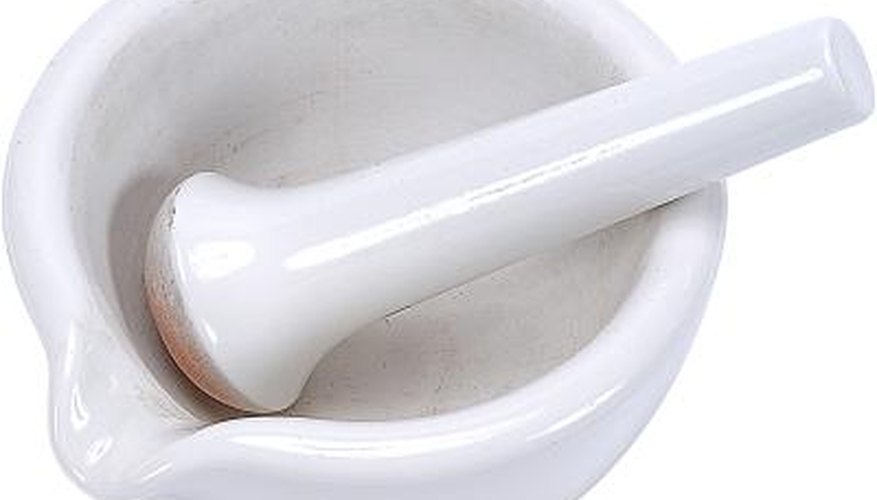The mortar and pestle is used in cooking to grind and blend ingredients into powder or paste. These kitchen tools are also used in pharmaceutical medicine to grind compounds and create drug mixtures. Cooks claim that using a mortar and pestle provides advantages in taste, textures and freshness of ingredients. In pharmaceuticals, this method gives the chemist an opportunity to create his own compounds. However, there are still some disadvantages to using a mortar and pestle in both medicine and cooking.
Manual Power
The mortar and pestle requires repetitive motion under a lot of force in order to grind and mix. The pestle is used to exert the force onto the herb, seeds and sauces in the mortar bowl. However, the cook's hand grips the slender cylinder-shaped pestle to accomplish this. Continued use of the mortar and pestle can lead to carpal tunnel syndrome. Users with arthritis and other bone and joint problems can exacerbate those problems using the pestle. Impatient cooks and chemists may also find the elbow grease needed to use this tool unnecessary, considering the modern options available.
- The mortar and pestle requires repetitive motion under a lot of force in order to grind and mix.
- The pestle is used to exert the force onto the herb, seeds and sauces in the mortar bowl.
Maintenance
Stone mortar and pestle sets are porous, making it difficult to clean them completely. Some cooks see the residue left after the last use as an advantage of the tools. However, not every spice or herb ground in the mortar makes a great mate in a recipe. Pharmacists use a ceramic mortar and pestle to allow for more thorough cleaning. However, ensuring that any type of mortar and pestle is free of the last compound mix can be difficult without sanitising after each use. Although lovers of the mortar and pestle find charm in them, cross contamination is still a concern.
- Stone mortar and pestle sets are porous, making it difficult to clean them completely.
- However, ensuring that any type of mortar and pestle is free of the last compound mix can be difficult without sanitising after each use.
Material Drawbacks
According to the cooking resource, "The Herb Companion," a mortal and pestle isn't all-purpose. The mortar and pestle are made from porcelain, lava stone, granite, iron and even wood. The various materials are suited for various compounds. For example, stone is best for dried herbs and seeds, while pesto and mayonnaise are best created in a marble, glass or porcelain version. Wooden pestles are suited for decoration or infrequent use since the material retains the flavours and aromas of each use. Committed mortar and pestle users must have more than one available, made of materials to accommodate each use.
- According to the cooking resource, "The Herb Companion," a mortal and pestle isn't all-purpose.
- Wooden pestles are suited for decoration or infrequent use since the material retains the flavours and aromas of each use.
Rise of Electronics
The mortar and pestle are manual versions of the electric grinders, food processors and blenders used today. These electric tools do the same job but in a faster and more efficient manner. They also create a product that is more fine and more completely incorporated than that created by the pestle. Although the mortar and pestle can be a decorative and novel part of the average cook's kitchen, its electric counterparts are the ones doing the job on a daily basis.
- The mortar and pestle are manual versions of the electric grinders, food processors and blenders used today.
- Although the mortar and pestle can be a decorative and novel part of the average cook's kitchen, its electric counterparts are the ones doing the job on a daily basis.
